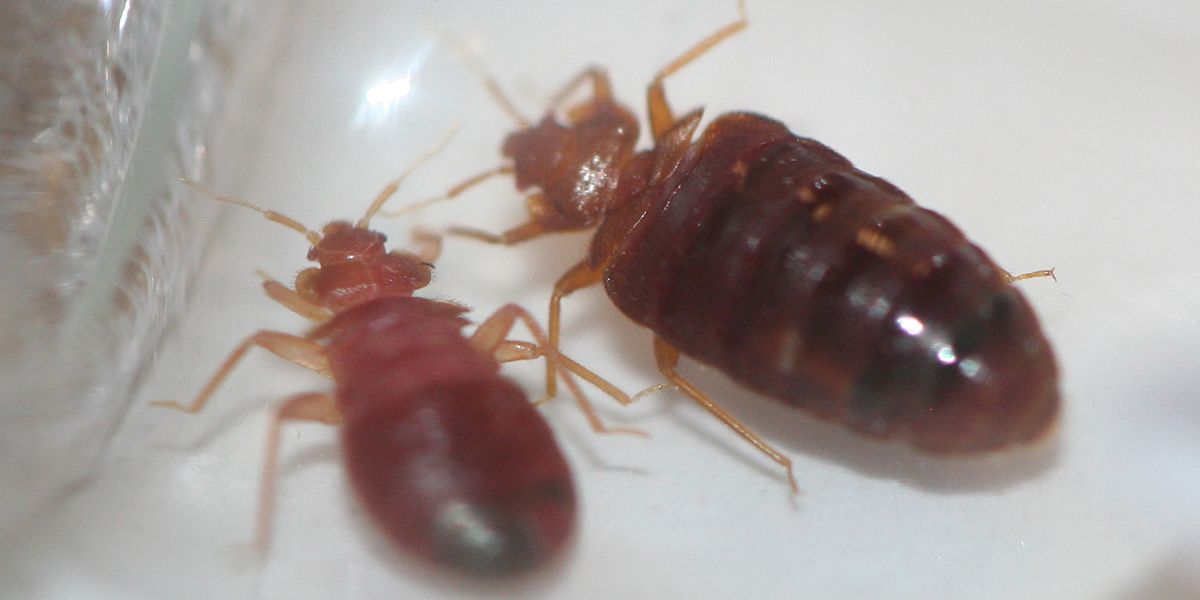
bed bugs
Bed bugs are small, nocturnal insects that feed on the blood of humans and animals.
-
What do bed bugs look like?
Bed bugs are small, nocturnal insects that are reddish-brown in color. Adult bed bugs are about the size of an apple seed, measuring approximately 5-7 mm in length. They have a flat, oval-shaped body when they haven't fed recently. After feeding on blood, their bodies become more elongated and redder in color.
-
Nuisance or danger?
Bed bugs are generally considered a nuisance rather than a danger. They do not transmit diseases to humans. However, their bites can cause itching and discomfort, and in some cases, allergic reactions that result in severe itching, swelling, or redness. The knowledge or suspicion of their presence can lead to sleep disturbances or insomnia. Scratching the bites might lead to secondary skin infections. Moreover, dealing with a bed bug infestation can be a stressful experience, potentially leading to feelings of shame, distress, and isolation, even though bed bugs are not associated with uncleanliness or poor hygiene.
-
How do I know if I have bed bugs?
Knowing if you have bed bugs involves looking for physical signs of their presence. Here are key indicators:
1. Bites: Wake up with itchy bites you didn't have when you went to sleep. Bed bug bites are often red, itchy, and can appear in a line or cluster.
2. Blood Stains: Small blood stains on your sheets or pillowcases, which occur when you unknowingly squish bed bugs that have fed.
3. Dark or Rusty Spots: Bed bug excrement leaves behind dark or rusty spots on sheets, mattresses, bed clothes, and walls.
4. Eggs and Eggshells: Tiny (about 1mm) pale yellow skins that nymphs shed as they grow larger.
5. Live Bed Bugs: Spotting the bugs themselves, especially in and around the bed or sofa seams, tags, and in cracks and crevices in the bed frame and headboard.
6. Unpleasant Odor: A strong, musty odor from the bugs' scent glands may be noticeable in heavily infested rooms.
If you notice any of these signs, it might be time to inspect your sleeping area thoroughly and give us a call at BugZ Termite and Pest Control for confirmation and treatment options.
-
Why do I have them?
Having bed bugs is not a reflection of personal hygiene or cleanliness. These pests are opportunistic and can be introduced to a clean environment as easily as to a cluttered one. Here are common ways bed bugs find their way into your home:
1. Travel: Bed bugs are expert hitchhikers and can come into your home on luggage, clothing, and other personal items from infested environments such as hotels, hostels, or public transport.
2. Second-Hand Items: Furniture, mattresses, and clothing that are bought used can harbor bed bugs.
3. Neighboring Infestations: In multi-unit buildings like apartments and hotels, bed bugs can move between units through tiny cracks and crevices in walls, floors, and ceilings.
4. Visitors: Guests can inadvertently bring bed bugs into your home on their belongings.
Preventing bed bugs involves being vigilant about inspecting second-hand items before bringing them into your home, using protective covers on mattresses, and exercising caution while traveling, such as inspecting hotel rooms and keeping luggage away from beds and walls.
-
What should I do if I have bed bugs?
If you suspect you have bed bugs, taking prompt and thorough action is crucial. Here’s a step-by-step approach to dealing with the infestation:
1. Confirm the Infestation: Look for physical signs of bed bugs, such as live bugs, excrement, eggs, or blood stains on your bedding or mattress.
2. Don’t Panic: While it's unsettling, remember that bed bugs can be managed with the right approach. Avoid moving to your sleeping location or throwing out all your belongings, as this can spread infestation.
3. Containment: Encase your mattress and box springs with a tightly woven, zippered cover to prevent bed bugs from entering or escaping. Bed bugs can live up to a year without feeding, so keep the cover on for at least a year to ensure all bugs and their eggs are dead.
4. Declutter: Reduce hiding places for bed bugs by eliminating clutter around your bed and in your room.
5. Laundry: Wash and dry your bedding, curtains, and clothes at the highest temperature setting possible. Bed bugs and their eggs can be killed by high temperatures.
6. Vacuum: Regularly vacuum your bed, bed frame, furniture, and floors to remove bed bugs and their eggs. Immediately dispose of the vacuum cleaner bag in a sealed plastic bag outside your home.
8. Call BugZ Termite and Pest Control: In many cases, especially severe infestations, DIY methods are not effective. Our professional exterminators have the experience, equipment, and access to more potent treatments that are not available to the public.
9. Monitor and Repeat: Bed bug elimination often requires multiple treatments and continuous monitoring to ensure all bed bugs and their eggs are eradicated. Keep checking regularly for signs of activity.
10. Prevent Future Infestations: Take preventive measures such as inspecting second-hand furniture before bringing it into your home, using protective covers on mattresses, and being vigilant while traveling to avoid reintroducing bed bugs to your home.
Addressing a bed bug infestation can be a long and challenging process. Patience and persistence are key to effectively getting rid of bed bugs.
-
What Treatment is effective and how do I prepare for it?
Call our Bugz Termite and Pest Control team at the first signs of Bed Bugs. Bug-Z takes the safety of your family and pets very seriously. That’s why we only use EPA registered pesticides. Your Bug-Z Termite and Pest Control professional will discuss all necessary safety precautions.
Preparation:
1. Declutter: Remove clutter from your home to eliminate bed bug hiding spots. Be cautious with infested items to prevent spreading the bugs.
2. Laundry: Wash all your bedding, clothing, and curtains in hot water and dry them on the highest dryer setting. For items that cannot be washed, dry them for 30 minutes at a high temperature.
3. Encase Mattresses and Box Springs: Use bed bug-proof covers to encase your mattresses and box springs, trapping any bed bugs inside and preventing others from entering.
4. Move Your Bed: Ensure your bed is not touching any walls or furniture. Place bed bug interceptors under all bed legs to catch bugs attempting to climb up.
5. Vacuum: Vacuum your entire home thoroughly, including all furniture, floors, and carpets. Immediately dispose of the vacuum bag in a sealed plastic bag outside your home.
6. Repair and Seal: Seal all cracks and crevices around baseboards, light sockets, etc., to eliminate bed bug hiding places.
Preparing your home for treatment is crucial for the success of any bed bug eradication effort. Cooperation with BugZ Termite and Pest Control, following their instructions closely, and possibly preparing for more than one treatment session are key steps in effectively managing a bed bug infestation.
"If you can’t kill them…call us!"
© 2024 All Rights Reserved | Bug-Z Termite & Pest Control


